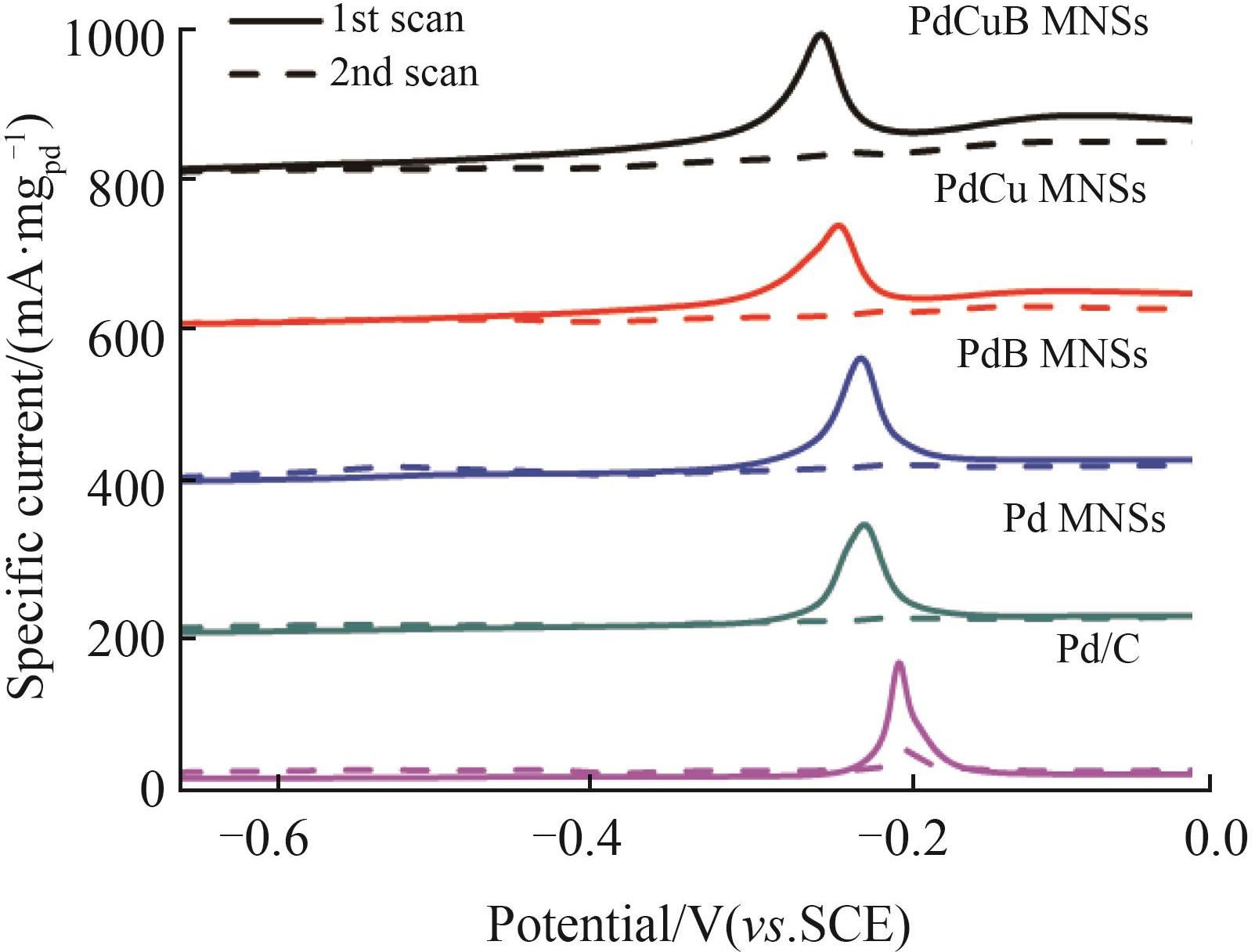
应用化学 ›› 2022, Vol. 39 ›› Issue (4): 673-684.DOI: 10.19894/j.issn.1000-0518.210449
介孔钯-硼合金纳米颗粒的制备和甲醇氧化电催化性能
- 四川大学化学学院,绿色化学与技术教育部重点实验室,成都 610064
-
收稿日期:2021-09-02接受日期:2021-12-29出版日期:2022-04-01发布日期:2022-04-19 -
通讯作者:刘犇 -
基金资助:超分子结构与材料国家重点实验室开放课题项目(sklssm2021011);中央高校基本科研业务费专项资金资助
Mesoporous Palladium⁃Boron Alloy Nanocatalysts: Synthesis and Performance in Methanol Oxidation Electrocatalysis
Li-Zhi SUN, Hao LYU, Xiao-Wen MIN, Ben LIU( )
)
- Key Laboratory of Green Chemistry and Technology of Ministry of Education,College of Chemistry,Sichuan University,Chengdu 610064,China
-
Received:2021-09-02Accepted:2021-12-29Published:2022-04-01Online:2022-04-19 -
Contact:Ben LIU -
About author:ben.liu@scu.edu.cn
-
Supported by:the Open Project of State Key Laboratory of Supramolecular Structure and Materials(sklssm2021011);the Fundamental Research Funds for the Central Universities
摘要:
合金化可以调节贵金属纳米材料的物理化学性质,从而显著提升它们的电催化性能。尽管合金化在过去的20多年里已取得诸多成果,但是如何充分发挥纳米合金的组分优势仍需深入的探究。本研究通过一步溶液相合成法实现了类金属硼(B)合金化的钯基介孔纳米催化剂材料的合成,同时探究了B原子的组分优势和介孔形貌的结构优势在碱性介质中电化学甲醇氧化反应(MOR)的协同作用。最优PdCuB介孔纳米催化剂表现出优异的电化学MOR活性和稳定性。机理研究表明,优异的催化活性源于B原子在Pd基介孔纳米催化剂中的积极协同作用;该协同作用通过电子效应(改变Pd的表面电子结构从而减弱CO基中间体的吸附)和双功能效应(促进OH-的吸附从而氧化CO基中间体)在动力学上加速了有毒CO基中间体的去除(提高甲醇氧化的决速步骤)。同时,B原子的间隙插入和介孔结构抑制了物理奥斯特瓦尔德(Ostwald)熟化过程,显著增加了催化剂的稳定性。
中图分类号:
引用本文
孙立智, 吕浩, 闵晓文, 刘犇. 介孔钯-硼合金纳米颗粒的制备和甲醇氧化电催化性能[J]. 应用化学, 2022, 39(4): 673-684.
Li-Zhi SUN, Hao LYU, Xiao-Wen MIN, Ben LIU. Mesoporous Palladium⁃Boron Alloy Nanocatalysts: Synthesis and Performance in Methanol Oxidation Electrocatalysis[J]. Chinese Journal of Applied Chemistry, 2022, 39(4): 673-684.
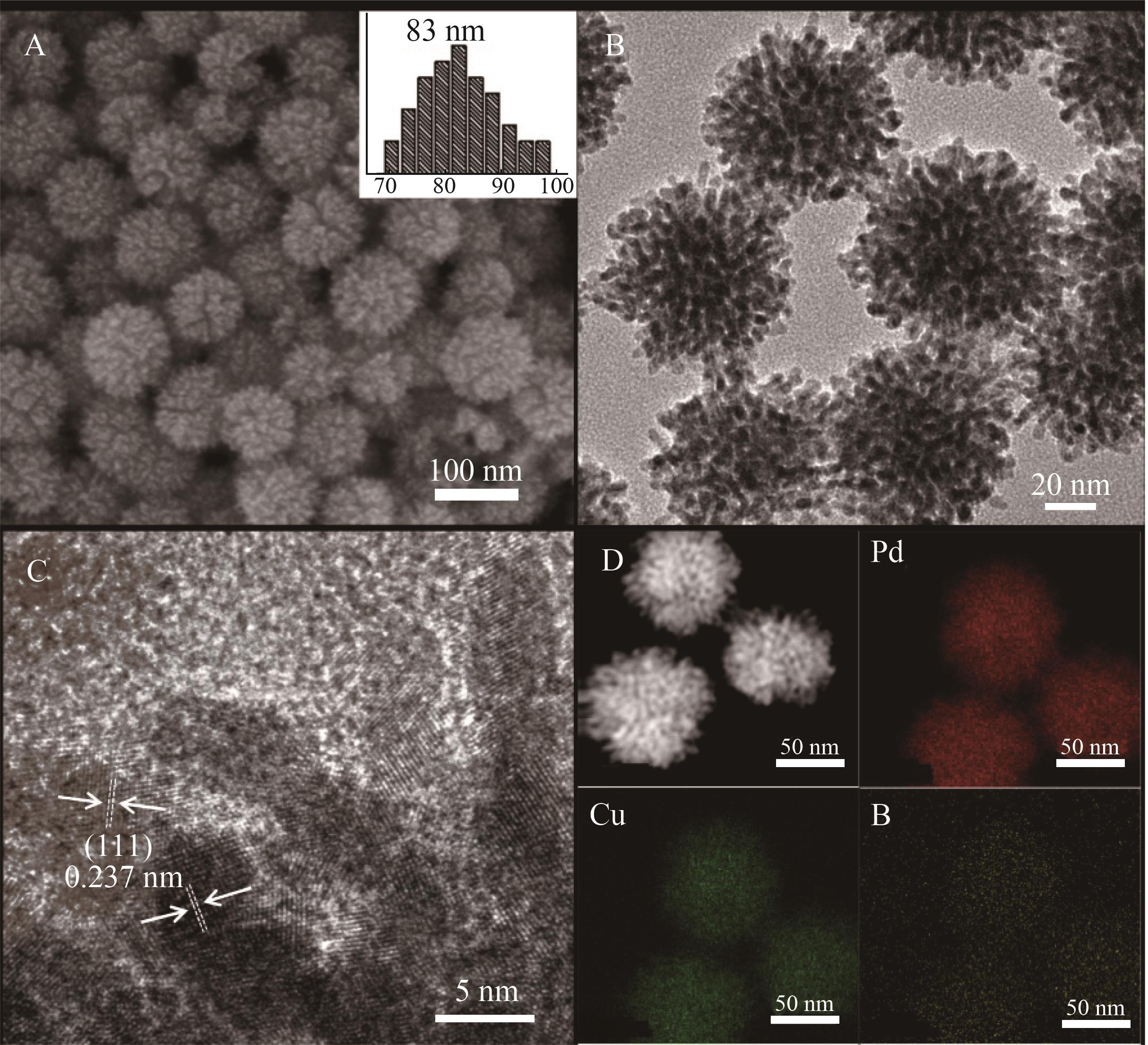
图2 PdCuB MNSs 的结构和组分表征(A) Low-magnification SEM images; (B) high-magnification TEM image; (C) high-resolution TEM image; (D) STEM EDS elemental mappings
Fig.2 Structural and compositional characterizations of PdCuB MNSs

图3 (a)Pd MNSs、(b)PdB MNSs、(c)PdCu MNSs和(d)PdCuB MNSs的XRD谱图(A)及其在35~50(°)范围内的XRD谱图(B)
Fig.3 (A) XRD and (B) zoom-in XRD patterns in the range of 35~50(°) of (a) Pd MNSs, (b) PdB MNSs, (c) PdCu MNSs and (d) PdCuB MNSs
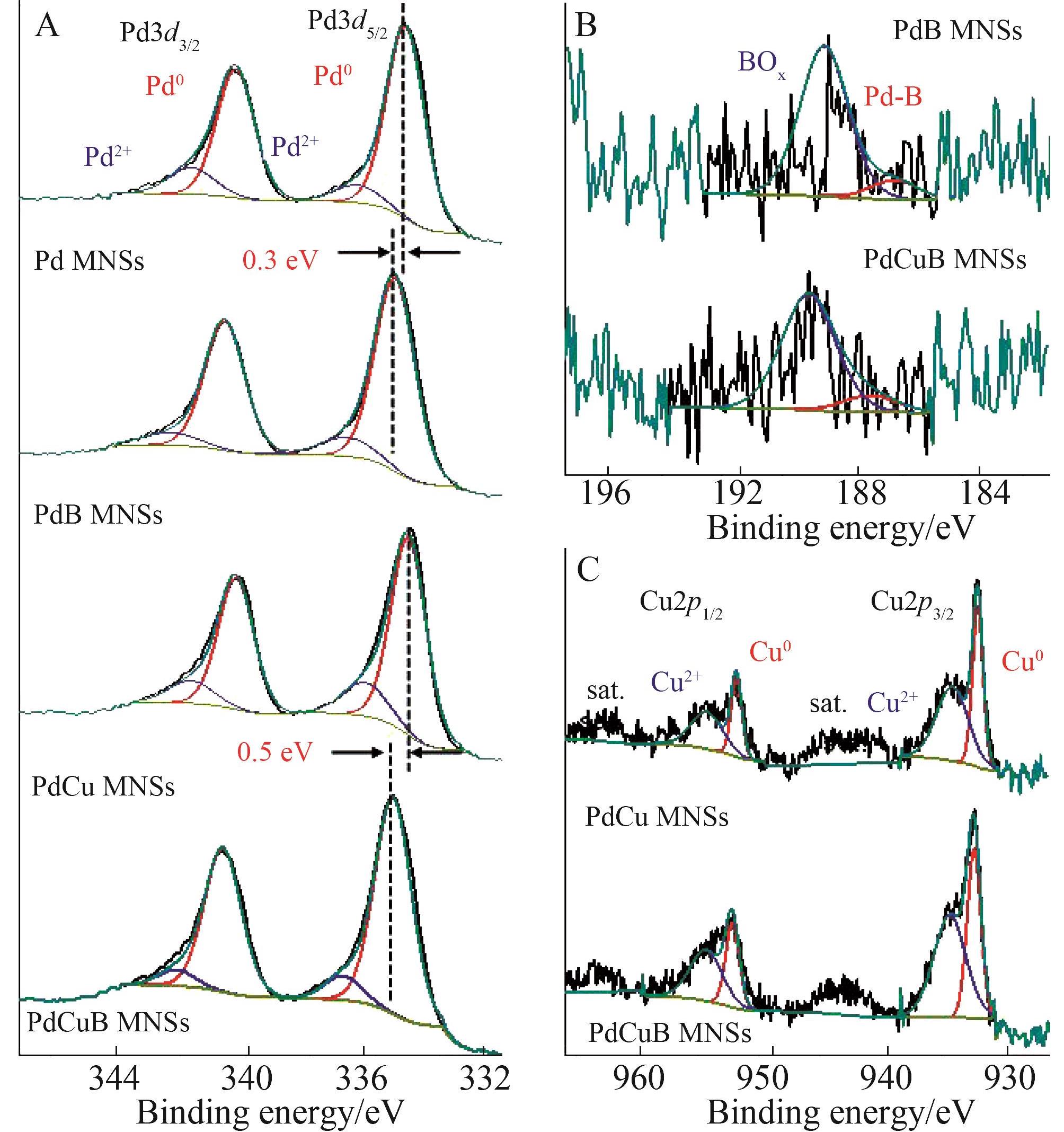
图4 Pd MNSs、PdB MNSs、PdCu MNSs、PdCuB MNSs的高分辨率(A)Pd3d、(B)B1s、(C)Cu2p XPS谱图
Fig.4 High-resolution (A) Pd3d, (B) B1s and (C) Cu2p XPS spectra of Pd MNSs, PdB MNSs, PdCu MNSs and PdCuB MNSs

图5 KOH中的电化学性能。Pd/C、Pd MNSs,、PdB MNSs、PdCu MNSs和PdCuB MNSs的(A) CV曲线和(B) 总结的ECSA值;(C)不同扫描速率下PdCuB MNSs的CV曲线;(D)扫描速率与峰值电流之间的关系图
Fig.5 Electrochemical performance in KOH. (A) CV curves and (B) summarized ECSAs of Pd/C, Pd MNSs, PdB MNSs, PdCu MNSs and PdCuB MNSs. (C) CV curves of PdCuB MNSs collected with different scan rates. (D) Relationships between scan rates and peak specific currents of Pd/C, Pd MNSs, PdB MNSs, PdCu MNSs and PdCuB MNSs
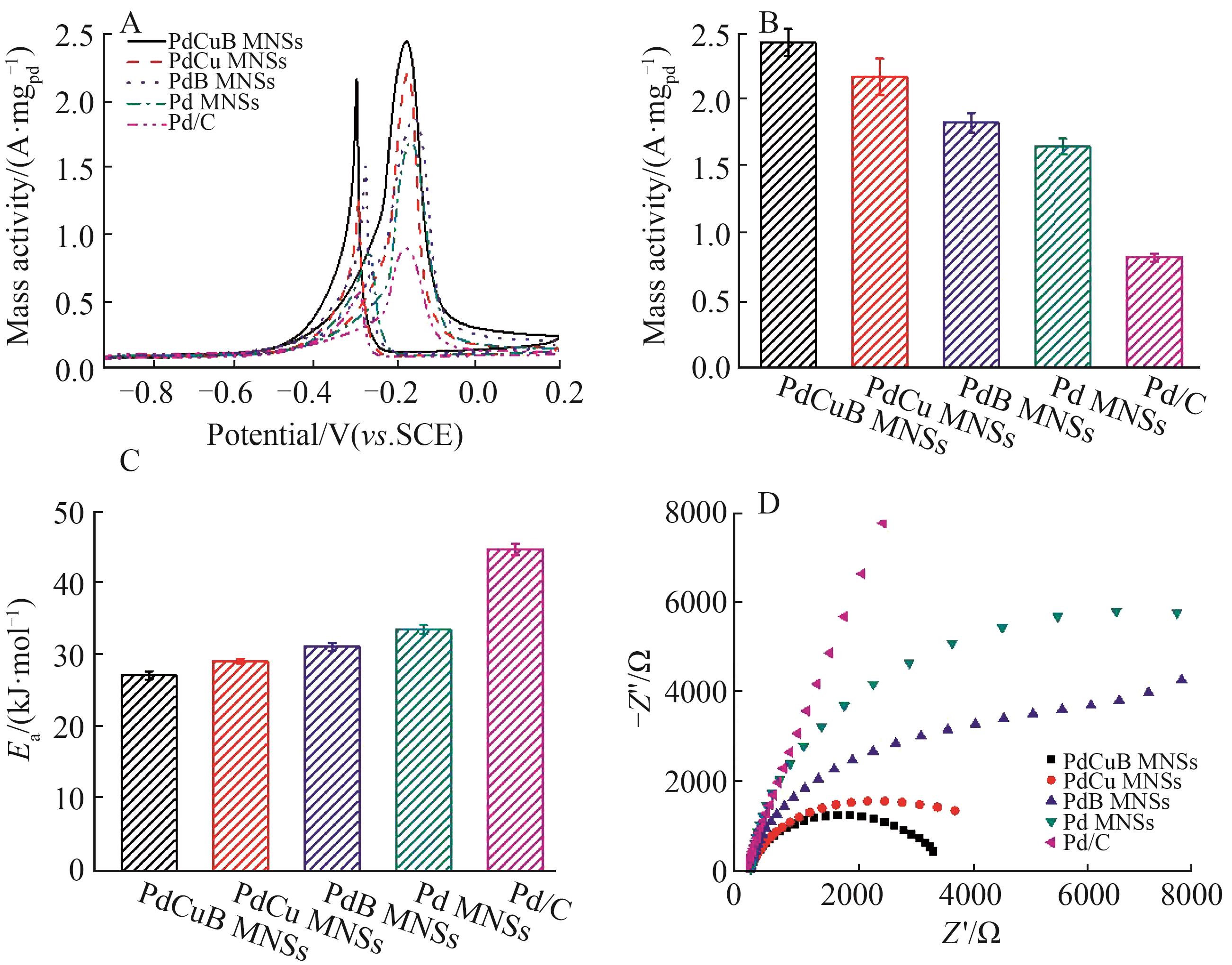
图7 甲醇氧化电化学性能。Pd/C、Pd MNSs、PdB MNSs、PdCu MNSs和PdCuB MNSs的(A)CV曲线和(B)质量活性的总结;(C)表观活化能值Ea;(D)奈奎斯特图
Fig.7 Electrochemical MOR performance. (A) CV curves, (B) summarized mass activities, (C) Eavalues, and (D) Nyquist plots of Pd/C, Pd MNSs, PdB MNSs, PdCu MNSs and PdCuB MNSs
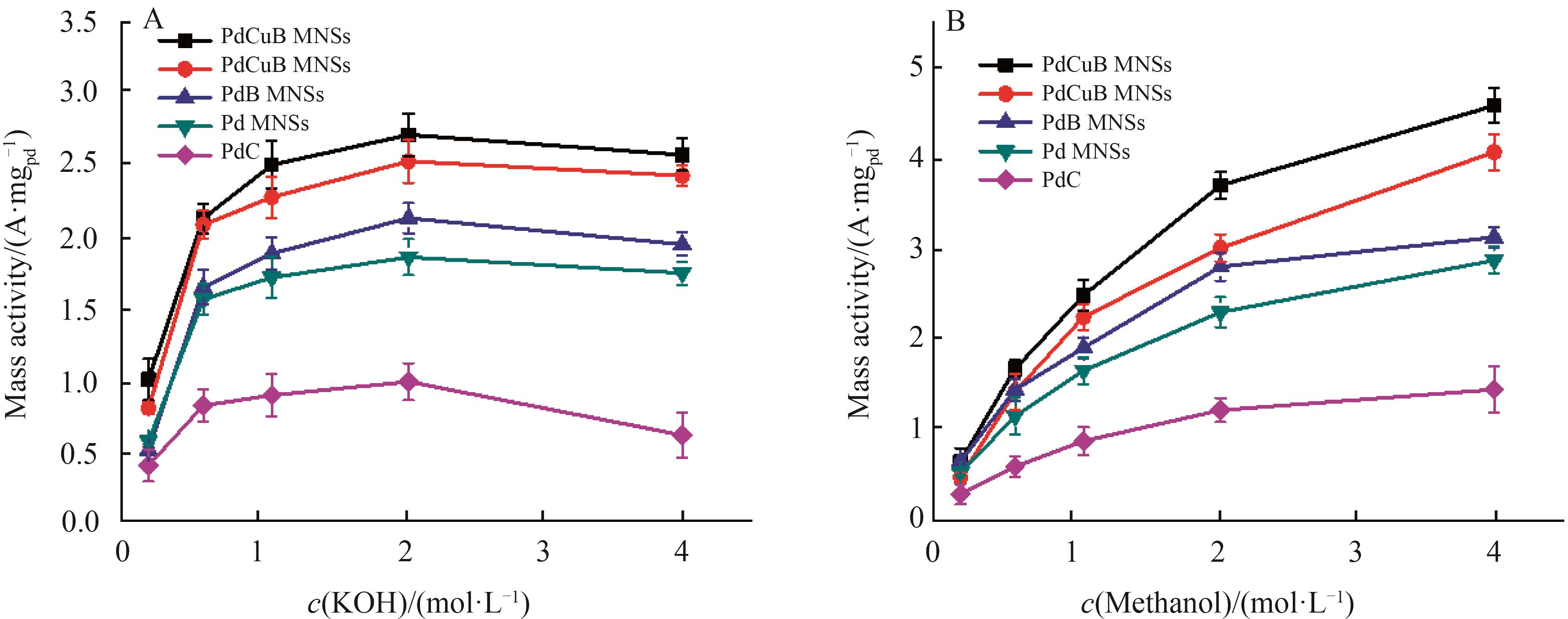
图8 (A) KOH浓度与Pd/C、Pd MNSs、PdB MNSs、PdCu MNSs和PdCuB MNSs的 MOR活性的关系;(B)甲醇浓度与Pd/C、Pd MNSs、PdB MNSs、PdCu MNSs和PdCuB MNSs MOR活性的关系
Fig.8 (A) The relationship between KOH concentrations and MOR activities of Pd/C, Pd MNSs, PdB MNSs, PdCu MNSs, and PdCuB MNSs; (B) The relationship between methanol concentrations and MOR activities of Pd/C, Pd MNSs, PdB MNSs, PdCu MNSs and PdCuB MNSs
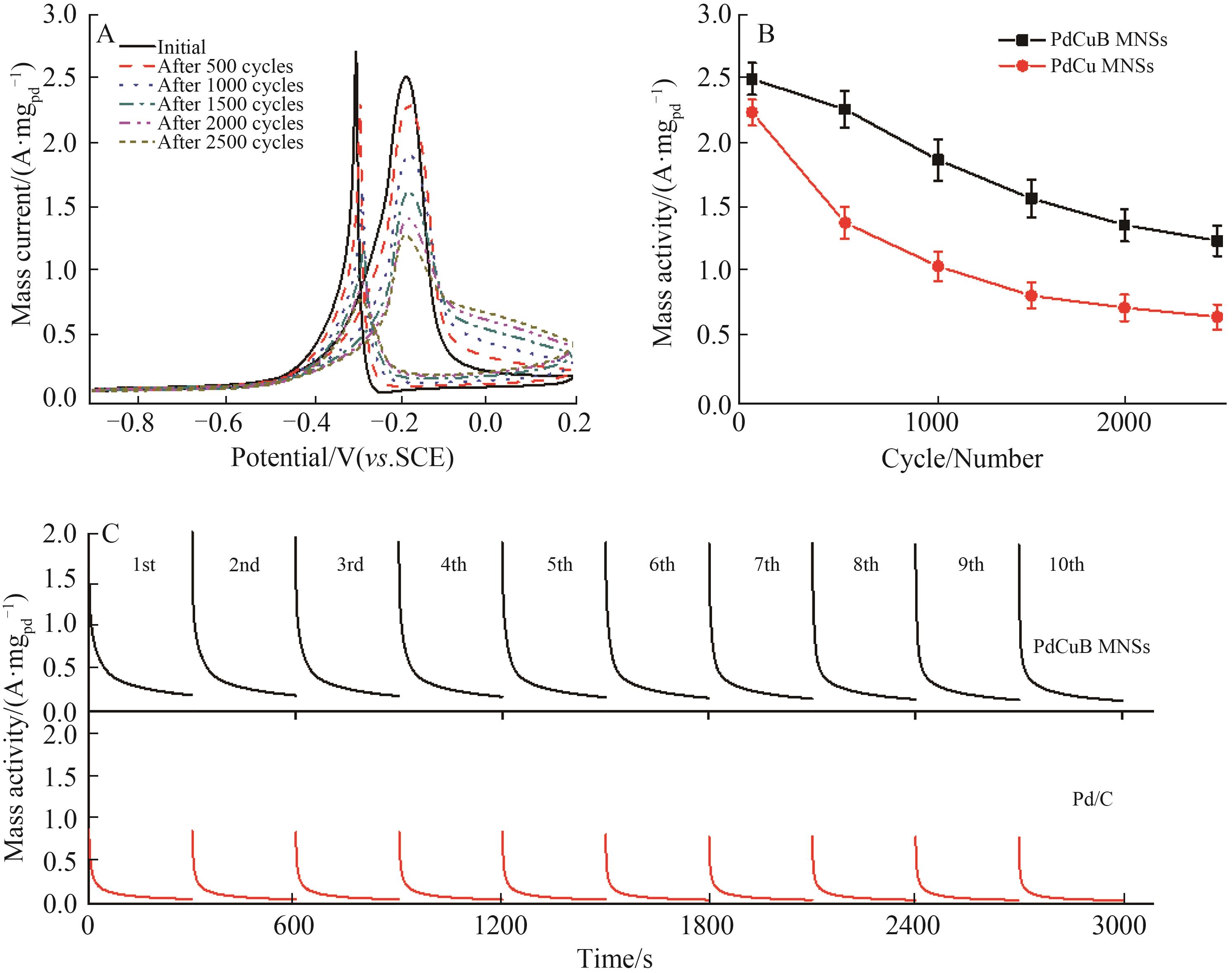
图9 PdCuB MNSs和PdCu MNSs在2500个CV循环扫描过程中的(A)CV曲线和(B)质量活性总结图。(C)PdCuB MNSs和Pd/C的10个测试周期的i-t曲线
Fig.9 (A) CV curves and (B) summarized mass activities of PdCuB MNSs and PdCu MNSs during CV scans for 2500 cycles. (C) MOR i-t curves of PdCuB MNSs and Pd/C with ten test cycles
| 1 | SEH Z W, KIBSGAARD J, DICKENS C F, et al. Combining theory and experiment in electrocatalysis: insights into materials design[J]. Science, 2017, 355(6321): 146. |
| 2 | PANWAR N L, KAUSHIK S C, KOTHARI S. Role of renewable energy sources in environmental protection: a review[J]. Renew Sustainable Energy Rev, 2011, 15(3): 1513-1524. |
| 3 | YUE X, HE C, ZHONG C, et al. Fluorine-doped and partially oxidized tantalum carbides as nonprecious metal electrocatalysts for methanol oxidation reaction in acidic media[J]. Adv Mater, 2016, 28(11): 2163-2169. |
| 4 | SCOFIELD M E, KOENIGSMANN C, WANG L, et al. Tailoring the composition of ultrathin, ternary alloy PtRuFe nanowires for the methanol oxidation reaction and formic acid oxidation reaction[J]. Energy Environ Sci, 2015, 8(1): 350-363. |
| 5 | ZHAO W Y, NI B, YUAN Q, et al. Highly active and durable Pt72Ru28 porous nanoalloy assembled with sub-4.0 nm particles for methanol oxidation[J]. Adv Energy Mater, 2017, 7(8): 1601593. |
| 6 | HUANG H, YANG S, VAJTAI R, et al. Pt-decorated 3D architectures built from graphene and graphitic carbon nitride nanosheets as efficient methanol oxidation catalysts[J]. Adv Mater, 2014, 26(30): 5160-5165. |
| 7 | BORGHEI M, LEHTONEN J, LIU L, et al. Advanced biomass-derived electrocatalysts for the oxygen reduction reaction[J]. Adv Mater, 2018, 30(24): 1703691. |
| 8 | KAKATI N, MAITI J, LEE S H, et al. Anode catalysts for direct methanol fuel cells in acidic media: do we have any alternative for Pt or Pt-Ru?[J]. Chem Rev, 2014, 114(24): 12397-12429. |
| 9 | SHI X, WEN Y, GUO X, et al. Dentritic CuPtPd catalyst for enhanced electrochemical oxidation of methanol[J]. ACS Appl Mater Inter, 2017, 9(31): 25995-26000. |
| 10 | CHU Y Y, WANG Z B, JIANG Z Z, et al. A novel structural design of a Pt/C-CeO2 catalyst with improved performance for methanol electro-oxidation by beta-cyclodextrin carbonization[J]. Adv Mater, 2011, 23(27): 3100-3104. |
| 11 | DU X, LUO S, DU H, et al. Monodisperse and self-assembled Pt-Cu nanoparticles as an efficient electrocatalyst for the methanol oxidation reaction[J]. J Mater Chem A, 2016, 4(5): 1579-1585. |
| 12 | ZHANG G, YANG Z, ZHANG W, et al. Nanosized Mo-doped CeO2 enhances the electrocatalytic properties of the Pt anode catalyst in direct methanol fuel cells[J]. J Mater Chem A, 2017, 5(4): 1481-1487. |
| 13 | SHI Y, FANG Y, ZHANG G, et al. Hollow PtCu nanorings with high performance for the methanol oxidation reaction and their enhanced durability by using trace Ir[J]. J Mater Chem A, 2020, 8(7): 3795-3802. |
| 14 | 孙墨杰, 吕涛, 徐维林. 微流控合成高活性甲醇氧化碳载铂钌电催化剂[J]. 应用化学, 2018, 35(5): 564-573. |
| SUN M J, LÜ T, XU W L. Microfluidic synthesis of high-activity PtRu/C catalyst for methanol electro-oxidation[J]. Chinese J Appl Chem, 2018, 35(5): 564-573. | |
| 15 | 黄火娣, 张晓凤, 张艺, 等. 铂/{还原氧化石墨烯/硅钨酸盐}n 复合物的制备及其电催化性能[J]. 应用化学, 2017, 34(10): 1209-1220. |
| HUANG H D, ZHANG X F, ZHANG Y, et al. Synthesis of Pt/{reduced graphene oxide/polyoxometalates}n composite films and their electrocatalytic performance[J]. Chinese J Appl Chem, 2017, 34(10): 1209-1220. | |
| 16 | SHAMRAIZ U, RAZA B, ULLAH S, et al. Low cost efficient Sr(OH)2 promoted Pd/rGO electrocatalyst for direct alcohol fuel cell[J]. Appl Surf Sci, 2020, 507: 145022. |
| 17 | 牛凤娟, 易清风. 纳米钯催化剂对甲醇的电催化氧化[J]. 电化学, 2011, 17(1): 67-72. |
| NIU F J,YI Q F. A titanium-supported nanoporous Pd electrocatalyst for methanol oxidation. electrochemistry[J]. 2011, 17(1): 67-72. | |
| 18 | 魏子栋, 李兰兰, 李莉, 等. 甲醇电化学催化氧化机理研究进展[J]. 化学通报, 2004, 67(1): 9-14. |
| WEI Z D, LI L L, LI L, et al. Mechanism of methanol oxidation on electrocatalysts[J]. Chin Chem Bull, 2004, 67(1): 9-14. | |
| 19 | LV H, LOPES A, XU D, et al. Multimetallic hollow mesoporous nanospheres with synergistically structural and compositional effects for highly efficient ethanol electrooxidation[J]. ACS Cent Sci, 2018, 4(10): 1412-1419. |
| 20 | DEBE M K. Electrocatalyst approaches and challenges for automotive fuel cells[J]. Nature, 2012, 486(7401): 43-51. |
| 21 | WANG D, XIN H L, HOVDEN R, et al. Structurally ordered intermetallic platinum-cobalt core-shell nanoparticles with enhanced activity and stability as oxygen reduction electrocatalysts[J]. Nat Mater, 2013, 12(1): 81-87. |
| 22 | LI C, XU Y, DENG K, et al. Metal-nonmetal nanoarchitectures: quaternary PtPdNiP mesoporous nanospheres for enhanced oxygen reduction electrocatalysis[J]. J Mater Chem A, 2019, 7(8): 3910-3916. |
| 23 | YOO J S, ZHAO Z J, NØRSKOV J K, et al. Effect of boron modifications of palladium catalysts for the production of hydrogen from formic acid[J]. ACS Catal, 2015, 5(11): 6579-6586. |
| 24 | KOBAYASHI K, KOBAYASHI H, MAESATO M, et al. Discovery of hexagonal structured Pd-B nanocrystals[J]. Angew Chem Int Ed, 2017, 56(23): 6578-6582. |
| 25 | LV H, SUN L, XU D, et al. Ternary metal-metalloid-nonmetal alloy nanowires: a novel electrocatalyst for highly efficient ethanol oxidation electrocatalysis[J]. Sci Bull, 2020, 65(21): 1823-1831. |
| 26 | WANG T, LI F, HUANG H, et al. Porous Pd-PdO nanotubes for methanol electrooxidation[J]. Adv Funct Mater, 2020, 30(21): 2000534. |
| 27 | ZHU J, CHEN S, XUE Q, et al. Hierarchical porous Rh nanosheets for methanol oxidation reaction[J]. Appl Catal B: Environ, 2020, 264: 118520. |
| 28 | LV H, SUN L, XU D, et al. Mesoporous palladium-boron alloy nanospheres[J]. J Mater Chem A, 2019, 7(43): 24877-24883. |
| 29 | LV H, XU D, SUN L, et al. Ternary palladium-boron-phosphorus alloy mesoporous nanospheres for highly efficient electrocatalysis[J]. ACS Nano, 2019, 13(10): 12052-12061. |
| 30 | SUN L, LV H, XU D, et al. Asymmetric PdPtCu mesoporous hemispheres on nitrogen-functionalized graphene for methanol oxidation electrocatalysis[J]. J Mater Chem A, 2020, 8(31): 15706-15714. |
| 31 | LV H, LV F, QIN H, et al. Single-crystalline mesoporous palladium and palladium-copper nanocubes for highly efficient electrochemical CO2 reduction[J]. CCS Chem, 2021: 1435-1444. |
| 32 | ZHU C, SHI Q, FU S, et al. Efficient synthesis of MCu (M=Pd, Pt, and Au) aerogels with accelerated gelation kinetics and their high electrocatalytic activity[J]. Adv Mater, 2016, 28(39): 8779-8783. |
| 33 | LI J, CHEN J, WANG Q, et al. Controllable increase of boron content in B-Pd interstitial nanoalloy to boost the oxygen reduction activity of palladium[J]. Chem Mater, 2017, 29(23): 10060-10067. |
| 34 | SUN L, LV H, WANG Y, et al. Unveiling synergistic effects of interstitial boron in palladium-based nanocatalysts for ethanol oxidation electrocatalysis[J]. J Phys Chem Lett, 2020, 11 (16): 6632-6639. |
| 35 | JIANG K, XU K, ZOU S, et al. B-doped Pd catalyst: boosting room-temperature hydrogen production from formic acid-formate solutions[J]. J Am Chem Soc, 2014, 136(13): 4861-4864. |
| 36 | JIANG B, ZHANG X G, JIANG K, et al. Boosting formate production in electrocatalytic CO2 reduction over wide potential window on Pd surfaces[J]. J Am Chem Soc, 2018, 140(8): 2880-2889. |
| 37 | VO DOAN T T, WANG J, POON K C, et al. Theoretical modelling and facile synthesis of a highly active boron-doped palladium catalyst for the oxygen reduction reaction[J]. Angew Chem Int Ed, 2016, 55(24): 6842-6847. |
| 38 | CHEN L, LIANG X, LI X, et al. Promoting electrocatalytic methanol oxidation of platinum nanoparticles by cerium modification[J]. Nano Energy, 2020, 73: 104784. |
| 39 | NGUYEN S T, LAW H M, NGUYEN H T, et al. Enhancement effect of Ag for Pd/C towards the ethanol electro-oxidation in alkaline media[J]. Appl Catal B: Environ, 2009, 91(1/2): 507-515. |
| 40 | CHEN L, LU L, ZHU H, et al. Improved ethanol electrooxidation performance by shortening Pd-Ni active site distance in Pd-Ni-P nanocatalysts[J]. Nat Commun, 2017, 8: 14136. |
| 41 | HONG J W, KIM Y, WI D H, et al. Ultrathin free-standing ternary-alloy nanosheets[J]. Angew Chem Int Ed, 2016, 55(8): 2753-2758. |
| 42 | LIANG W, WANG Y, ZHAO L, et al. 3D anisotropic Au@Pt-Pd hemispherical nanostructures as efficient electrocatalysts for methanol, ethanol, and formic acid oxidation reaction[J]. Adv Mater, 2021, 33(30): 2100713. |
| 43 | XU H, SHANG H, WANG C, et al. Recent progress of ultrathin 2D Pd-based nanomaterials for fuel cell electrocatalysis[J]. Small, 2021, 17(5): 2005092. |
| 44 | WANG T, SUN H, XUE Q, et al. Holey platinum nanotubes for ethanol electrochemical reforming in aqueous solution[J]. Sci Bull, 2021, 66(20): 2079-2089. |
| [1] | 修海祥, 刘万强, 尹东明, 程勇, 王春丽, 王立民. AB2型Laves相储氢合金研究进展[J]. 应用化学, 2023, 40(5): 640-652. |
| [2] | 张琴, 刘文彬, 樊利娇, 谢宇铭, 黄国林. 功能化介孔二氧化硅的制备及其吸附分离水中铀的研究进展[J]. 应用化学, 2023, 40(2): 169-187. |
| [3] | 王路飞, 甄蒙蒙, 沈伯雄. 贫电解液下电催化剂对调控锂硫电池性能的研究进展[J]. 应用化学, 2023, 40(2): 188-209. |
| [4] | 杜卫民, 刘欣, 朱琳, 付佳敏, 郭文山, 杨晓晴, 双培硕. 三元镍基硫属化物纳米棒阵列的简单合成及其高效的电催化析氧性能[J]. 应用化学, 2022, 39(8): 1252-1261. |
| [5] | 张超. 单原子催化剂电催化还原二氧化碳研究进展[J]. 应用化学, 2022, 39(6): 871-887. |
| [6] | 王岩, 张树聪, 汪兴坤, 刘志承, 王焕磊, 黄明华. 电解海水析氢反应过渡金属基催化剂的研究进展[J]. 应用化学, 2022, 39(6): 927-940. |
| [7] | 曹维锦, 白璐, 武兰兰, 李敬德, 宋术岩. 多壳层中空镍钴双金属磷化物纳米球用于高效电催化析氧[J]. 应用化学, 2022, 39(4): 666-672. |
| [8] | 商林杰, 刘江, 兰亚乾. 共价有机框架材料用于光/电催化CO2还原的研究进展[J]. 应用化学, 2022, 39(4): 559-584. |
| [9] | 张艺潆, 李翠艳, 赵杰, 余笑明, 方千荣. 卟啉-硫醚基共价有机框架材料用于氧还原反应电催化剂[J]. 应用化学, 2022, 39(4): 647-656. |
| [10] | 吴小峰, 陈德顺, 马伟, 黄科科. 电喷雾沉积WO3/Fe2TiO5复合光阳极及其光电催化水裂解性能[J]. 应用化学, 2022, 39(4): 694-696. |
| [11] | 吴利军, 郭守杰, 张超, 李知声, 李唯聪, 杨长春. 锂钠合金的原位电化学制备及“锂+钠”共储特性[J]. 应用化学, 2022, 39(11): 1757-1765. |
| [12] | 程广增, 刘帅, 王焕磊. 钾离子电池负极的高性能潜在材料:锑[J]. 应用化学, 2021, 38(2): 170-180. |
| [13] | 李宫, 金龙一, 姚鹏飞, 刘聪, 徐维林. 介孔炭负载铂纳米粒子的高效氧还原催化剂的可控设计[J]. 应用化学, 2021, 38(12): 1639-1646. |
| [14] | 毕一飘, 宫雪, 杨发, 阮明波, 宋平, 徐维林. 多价MnOx/C电催化剂用于高效氮还原反应[J]. 应用化学, 2020, 37(9): 1048-1055. |
| [15] | 李琳, 任慧敏, 卫博慧, 李军, 王杰, 李晖, 姚陈忠. 钒-氮共掺杂碳基介孔纳米材料的制备及氮还原电催化性能[J]. 应用化学, 2020, 37(8): 930-938. |
| 阅读次数 | ||||||
|
全文 |
|
|||||
|
摘要 |
|
|||||

